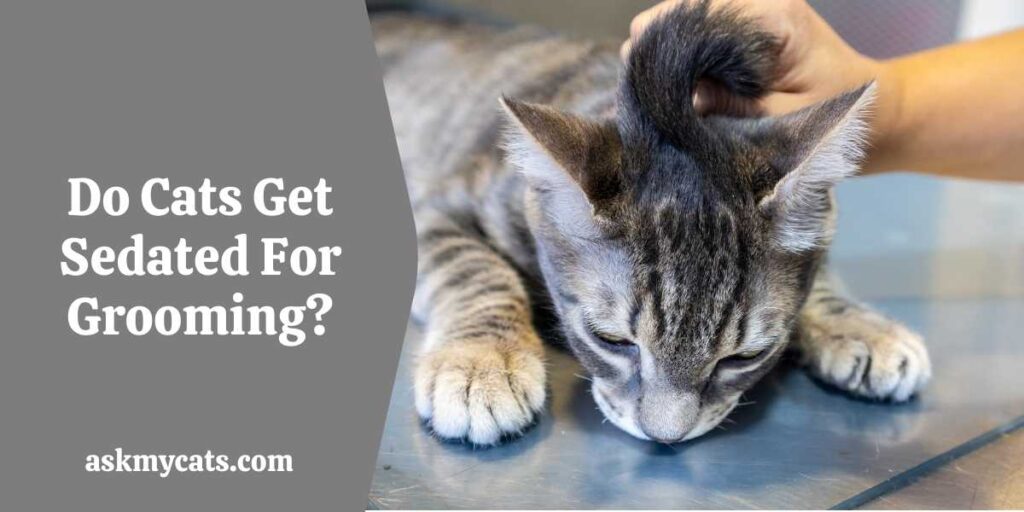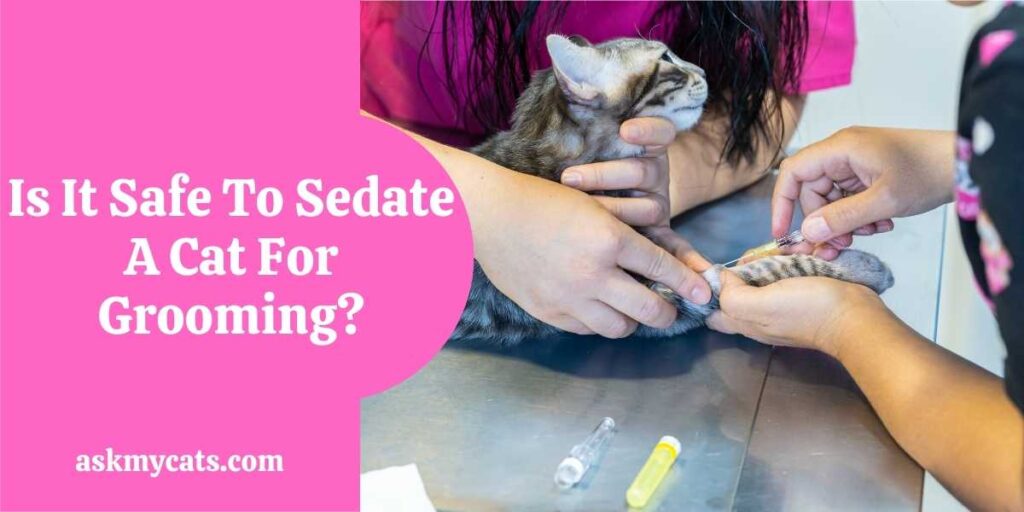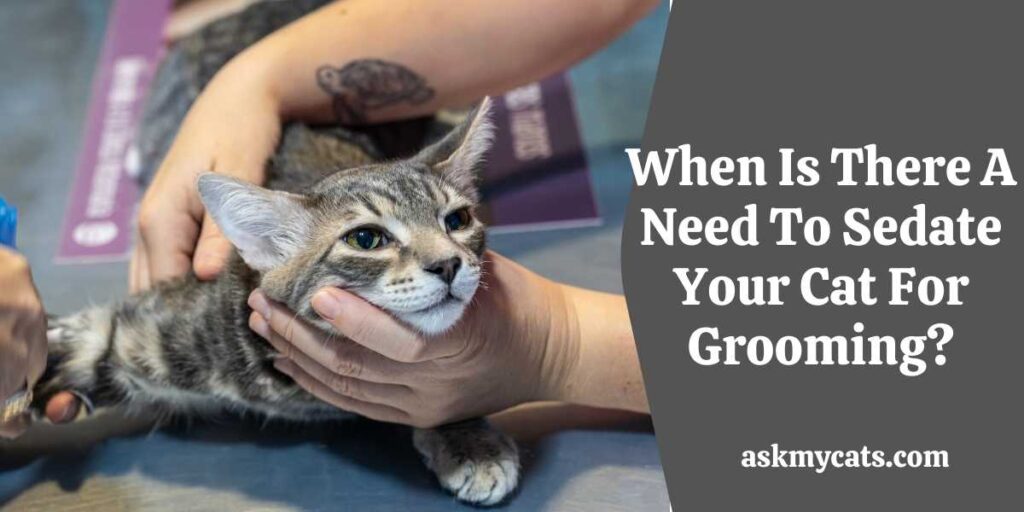Some cats despise being groomed, but maintenance is required if they have lengthy fur. If your cat’s coat isn’t free of mats and tangles, it might pull painfully on the skin of your cat, creating discomfort.
If grooming time for your cat feels like a scene from a horror movie with no happy ending insight, you may need to sedate your cat using sedative medications. This will assist in relieving tension and keeping your cat quiet and comfortable throughout the grooming procedure.
There are a few different ways to sedate your cat during grooming sessions if you’re having trouble keeping them calm. This will make grooming much more pleasant for both you and your cat!


Give Your Cat the Perfect Day
Get the Free Ebook!
Do Cats Get Sedated For Grooming?
Yes, cats get sedated for grooming. For some cats, the most humane approach to groom them gently is to use soothing medicine. Consult your veterinarian before using any of these medications. They may recommend a specific sedative for your cat based on their needs.

You may either give the anaesthetic and groom your cat at home or schedule a sedation and grooming appointment at your veterinarian’s office.
If you don’t want to use prescription medicine to sedate your cat for grooming, you might be able to locate a non-medicated alternative.
Calming treats for cats are made out of a combination of herbs that help cats relax and reduce tension.
Valerian, passionflower, chamomile, and catnip are all popular herbs. Each brand will employ a different combination of herbs, so if you know your cat likes a certain component, look for one that has it.
Calming collars include a synthetic version of cat pheromones, which can help people feel more secure and peaceful. They can frequently assist with stress-related behaviour, but they can also help your cat feel less worried in general.
Pheromone diffusers operate similarly to soothing collars, except that your cat must be within a particular range of the diffuser to feel the effects.
Bach Rescue Treatment is a homoeopathic remedy made out of the essence of five flowers to help with anxiety and tension. You may put the liquid in your cat’s food or water.
Pheromones or herbs are occasionally used in calming sprays to assist alleviate anxiety and tension.
To assist alleviate anxiety, homoeopathic anxiety pills contain trace quantities of pure, all-natural substances.
These provide pressure on your cat’s body, which is said to help them relax. They won’t function if they cover portions of your cat’s body that require grooming, but you’ll still be able to comb their legs, tummy and clip their nails if necessary.
Is It Safe To Sedate A Cat For Grooming?
It is safe to sedate a cat for grooming only if the sedatives are applied in a limited content and after taking consent from a veterinarian.

A veterinarian may decide to anaesthetize a cat to groom it in severe situations properly. This might be utilised if a longhaired cat with matted hair has been rescued and needs a substantial amount of hair trimmed away.
Anaesthesia is typically less unpleasant for a cat who has damaged skin from matting or is suffering from other issues such as flystrike.
A clean and well-groomed cat will be considerably more at ease than one with matted and unclean fur. So, instead of putting off those grooming sessions because you know your cat doesn’t enjoy them, try sedating your cat to keep them relaxed and stress-free.
Cats have a well-deserved reputation for independence and a limited tolerance for human interference in their everyday activities.
If your cat’s fur coat is dirty and he has mats that are beyond his ability to groom, he may not appreciate your assistance. It is sometimes essential for a cat’s health and well-being to sedate her for grooming.
Because the skin is a cat’s largest and most visible organ, its health indicates overall vitality. Of course, cats groom themselves, but selective breeding has resulted in coats that require more care than felines can provide on their own.
Combing, brushing, bathing, shaving, or medicated shampooing are some of the ways you may assist your cat with grooming.
When Is There A Need To Sedate Your Cat For Grooming?
You need to sedate your cat when your cat starts to create trouble during grooming.

Cats who dislike being washed often might benefit from a tranquillizer or anti-anxiety medicine.
If your cat is terrified of clippers or wants to get away from the grooming surface all the time, he may benefit from light to moderate anaesthesia.
Sedation, if not anaesthetic, is required for any in-depth grooming for medical reasons.
To groom feral or otherwise unsocial cats, they will most likely need to be sedated or anaesthetic. These cats aren’t wired to accept the close touch that proper grooming necessitates.
Consider anaesthesia for any grooming procedures taking too long or if your cat has a lot of matted hair. The more upset or impatient your cat becomes, the more likely a comb, brush, or scissors may cause harm.
Sedation makes accessing difficult-to-reach regions such as under the tail or armpits a snap since you have more positioning choices for your cat.
What Over The Counter Medicine Can I Use To Sedate My Cat?
You can use Benadryl to sedate your cat.
Benadryl is often used to treat itchy or allergic skin responses, vaccination reactions, and insect bites. The medication might be used as a moderate sedative for extended automobile rides on rare occasions.
Benadryl can be used as an anti-nausea or motion sickness drug, but if that’s the condition you’re seeking to treat, it’s preferable to use something else.
Benadryl, like individuals, may induce a broad range of symptoms. Your cat may be sleepy. The medicine can occasionally cause a cat to become agitated or hyperactive. Seizures, unconsciousness, breathing problems, and even death can result from overdosing.
Can I Give My Cat Benadryl For Grooming?
You can give your cat Benadryl for grooming with your vet’s consent because Benadryl is a safe and effective over-the-counter sedative for cats.
However, you should consult your veterinarian for the proper dosage and composition. Dry mouth, elevated heart rate, and urinary retention are some of the side effects.
Syringe liquid Benadryl is the most convenient way to medicate a cat. However, if the odour or flavour bothers them, many cats may refuse to eat it.
If your cat refuses to eat it, you may take it to a compounding pharmacy, where the staff can flavour the liquid with chicken, fish, or another cat-friendly flavour, increasing the chances of your cat taking it.
Pills can also be flavoured if you’d rather deliver the drug that way. You might also try mixing it with their food to see if they would eat it with their meal.
You’ll probably want to give half of a 25-milligram pill to an average-sized cat. To receive the proper dose, a 10-pound cat will probably need around four millilitres of liquid (available at a concentration of 12.5mg/5ml).
Cost To Sedate Cat For Grooming
Sedating a cat for grooming might cost anything from $200 to $300.
Grooming cats is more difficult than grooming dogs since these furballs dislike being held in various grooming positions.
To complete risk-free grooming in the salon, cats frequently require anaesthesia. The cost of sedated grooming is determined by the type of sedative administered to your cat.
Some groomers utilise over-the-counter sedatives that veterinarians have prescribed. Herbs, CBD oils, synthetic pheromones, and body wraps are among the non-medicinal sedatives used by others.
These sedative treatments are inexpensive, but cats require general anaesthetic to treat matted hair, parasites, and lacerations in rare circumstances. Only a professional veterinarian should use an injection or gas inhalation to sedate a cat.
Frequently Asked Questions
Is it OK to sedate my cat for grooming?
Grooming, travel, medical appointments, and other short-term activities are popular for this cat sedative. In healthy cats, gabapentin is usually regarded safe, with few negative effects. In pets who require a greater sedative effect, it’s frequently used in conjunction with other drugs.
How long does it take for Benadryl to sedate a cat?
This drug should take action within 1 to 2 hours, and clinical symptoms should improve as a result.
Can you give a cat something to sleep?
You can use sleeping medications, diphenhydramine, and benzodiazepines to sedate your cat for travel. Before giving your cat any sedatives, you should consult your veterinarian. They can create major issues if not administered appropriately.
Final Words
A happy cat is a well-groomed cat, and as a pet parent, it’s always reassuring to know that your cat is at ease. While grooming time might be difficult, there are safe and efficient techniques to sedate your cat so that the process can be completed without excessive aggressiveness, tension, or worry.
Ask your questions in the comments section below.
